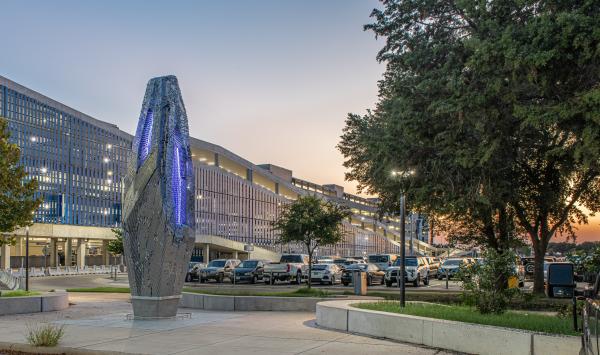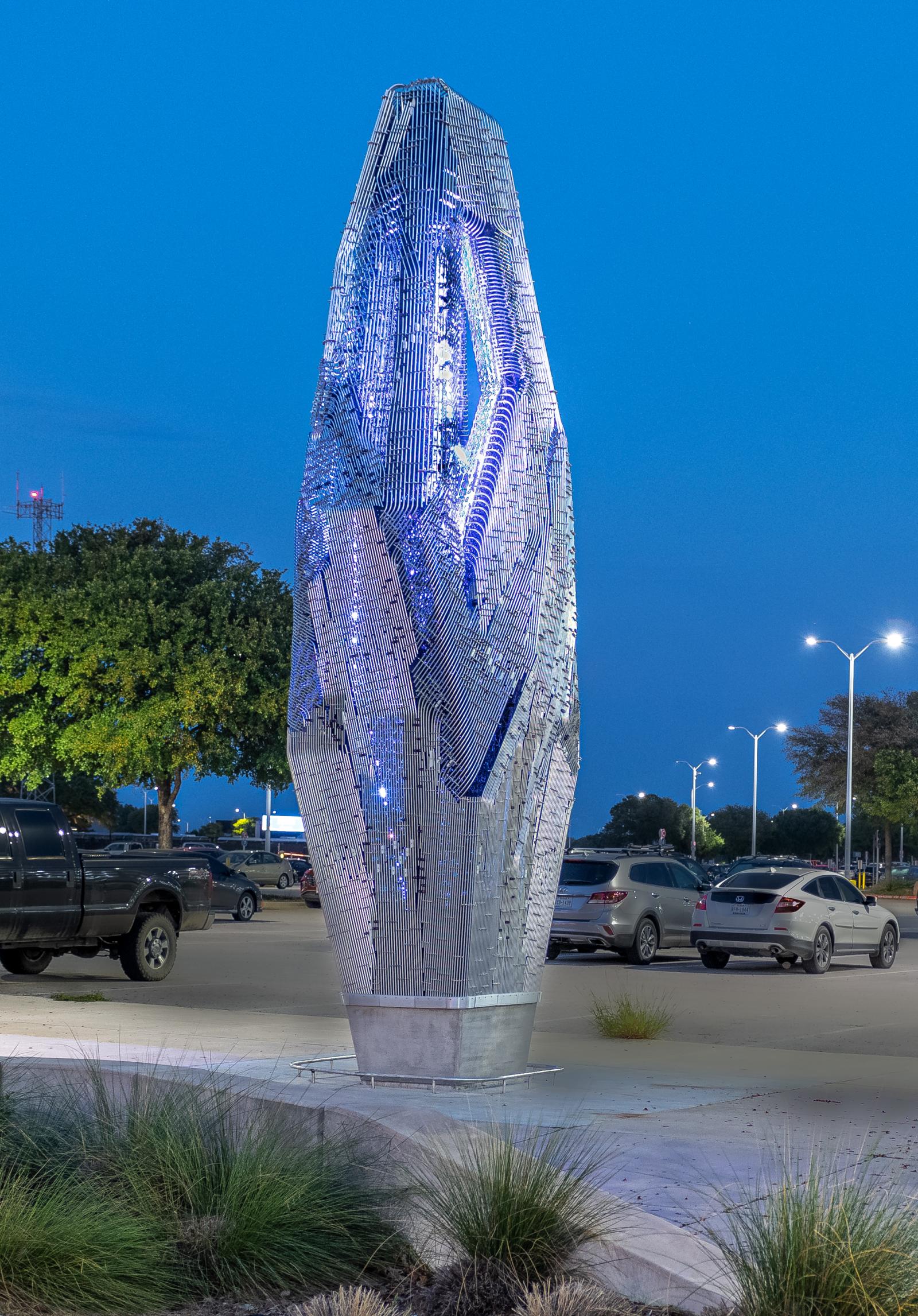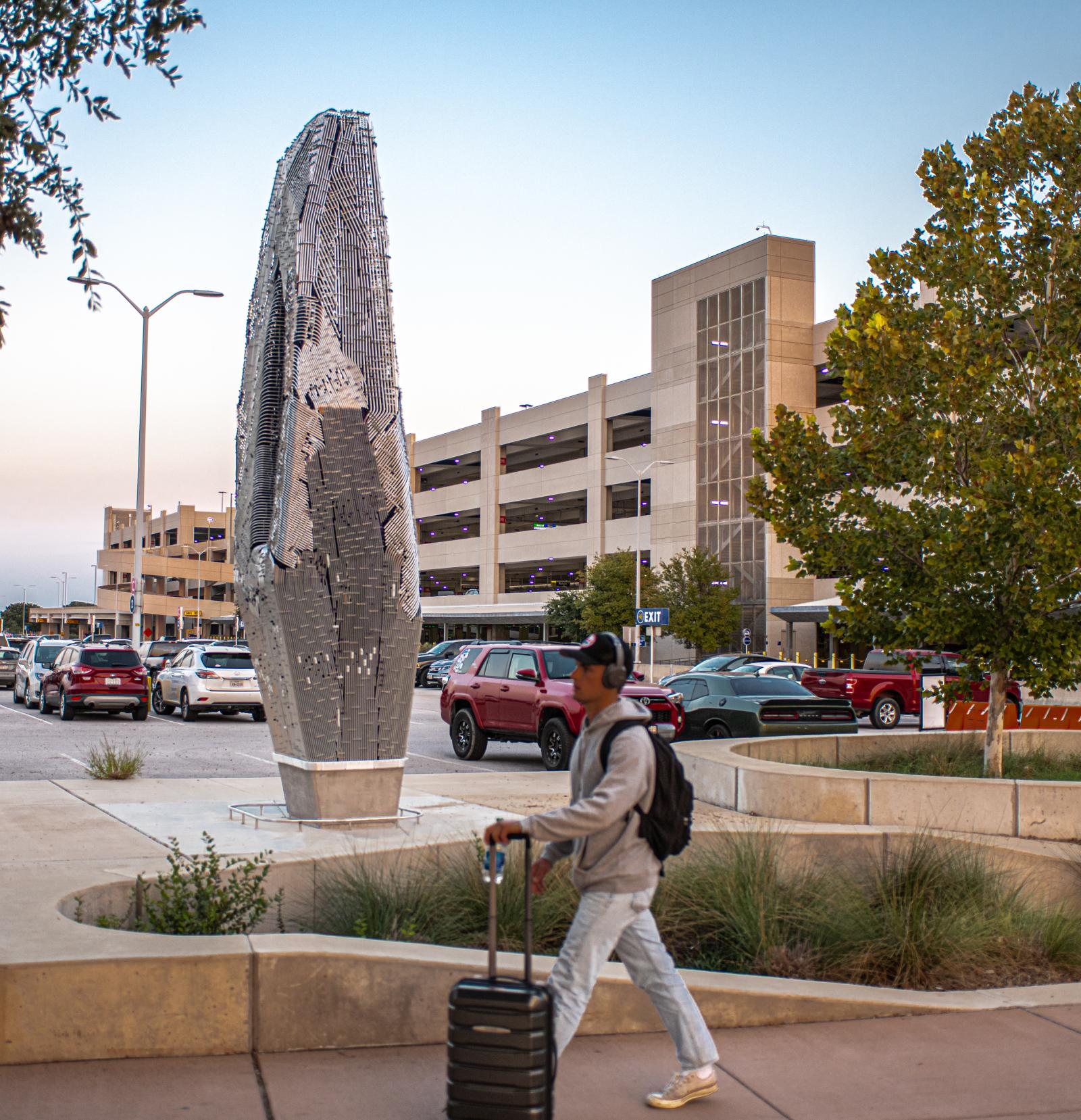Digitally Fabricated Public Art by Kory Bieg and Clay Odom

The next time you visit Austin Bergstrom International Airport, look out for PLUME, a new public art piece designed and fabricated by Associate Professors Kory Bieg and Clay Odom. Commissioned by the City of Austin for the Economic Development Department’s Art in Public Places program, the piece is located in a pedestrian walkway near the airport’s Surface Lot C, serving as both a wayfinding device and a welcome to the city.
Inspired by the iridescent feathers of the grackle, Austin’s unofficial mascot, and all the technologies and complexities of air travel, the piece is grounded in its specific site and the city of Austin. Just as grackle feathers shimmer in the Central Texas sun, PLUME reflects the blues of the sky and the colors in its surroundings, while at night, the structure disappears, and all that can be seen is the illuminated inner core. Designed to activate and anchor the pedestrian experience, the piece helps define a new section of the airport.
“In addition to working with the city and the airport throughout the project from concept through final assembly, we also surveyed passengers passing through the airport,” Odom said. “From this act of listening and collaboration, we knew this needed to be about the people who would see the work and its place in the city as much as it was about creating a singular work of art. Austin is at a crucial and exciting time in its history, and we felt like this was a collaboration not only with the direct stakeholders but also with a particular place and time.”
In designing and fabricating the piece, Bieg and Odom used several advanced technologies. The interior, developed in collaboration with Branch Technology, is a 3D printed core of carbon fiber-reinforced extruded material that supports an intricate skin of thousands of bent aluminum rods that were fabricated and assembled in collaboration with Drophouse Design. Additional structural engineering support was provided by LEAP Structures.
To ensure there were no conflicts, Odom and Bieg used a parametric 3D model to locate every part of the project, comprised of 5,200 linear feet of aircraft-grade individually bent aluminum rods assembled into larger panel groups. Hundreds of unique 3D-printed parts then connect the larger panel assemblies to the core, which, all in, weighs just over 1,000 lbs. Due to the number of unique parts and the complexity of the project, coordination between multiple technologies and fabrication methods was critical to the project’s success.
Reflecting on the piece and their collaboration, Bieg and Odom note: “The project is a part of our ongoing research about the translation of digitally conceived prototypes into permanent site-specific works that positively affect their urban contexts. We have collaborated on several other design-build installations—which also used digital technologies and design software to orchestrate a complex network of parts into unique and nonstandard geometries—but this was our first permanent piece, and we sought to push these concepts and methods further. The piece synthesizes our previous efforts into a singular conceptual, design, fabrication, and assembly process that defined the project’s aesthetic qualities, which can be appreciated at many scales as people move around and past the work.”
Since 1985, the city’s Art in Public Places (AIPP) program has collaborated with local and nationally-known artists to include Austin’s history and values into cultural landmarks that have become cornerstones of the city’s identity. Each year, AIPP brings eight to ten public art projects to life in parks, walkways, and public buildings across the city, funded by a percentage of eligible capital improvement project budgets.
“Public art provides a great platform for engaging place and for developing work that is either too complicated or too expensive for a typical building project,” Bieg said. “These sorts of projects also allow you to strip away some of the functional requirements of a building, so you can focus on manifesting the idea and evoking a feeling or sense of place that is open to interpretation. The effect that a public art project has on a viewer is immediate and, by its very nature, accessible. We like that these types of projects are out in the world and not tucked away to be experienced by only a few.”
To learn more about the PLUME and the Art in Public Places program, watch this short video about the piece developed by the City of Austin’s Cultural Arts Division:



